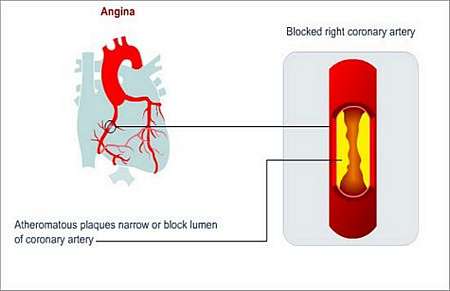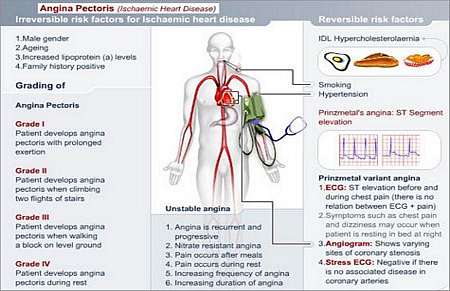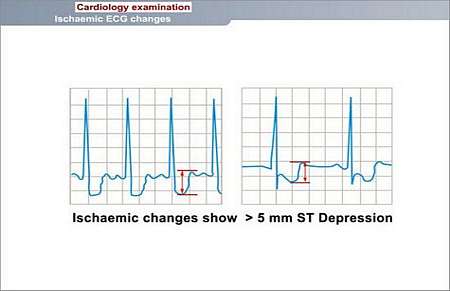What is ANGINA?
This is a word used to describe the feeling a patient experiences when the heart receives insufficient blood enriched with oxygen. Patients experience chest tightness or heaviness brought on by effort and relieved by rest. The sensation starts behind the breastbone and radiates across the chest. It is frequently associated with a leaden feeling in the arms. Occasionally, it may present in more unusual sites, e.g. pain in the jaws or teeth on effort, without pain in the chest. It may be confused with oesophageal (food-pipe) pain, or may present as pain in the pit of the stomach.
Although these symptoms are usually brought on by exertion, it may occur
- After exposure to cold
- After eating a heavy meal, or
- During emotional stress
Angina is also classified as stable or unstable
- Stable angina is induced by effort and relieved by rest; it does not increase in frequency or severity and is predictable in nature
- Unstable angina is of increasing frequency and severity; it is not only induced by effort, but may occur unpredictably, even at rest (this is a more serious type of angina, as it may progress to a heart attack)
Why does this happen and how may it affect the patients health?
There are many causes of angina. In a western population, disease of the blood vessels (the coronary arteries) that supply blood to the heart muscle is the most common one.

This disease causes a narrowing of these blood vessels. When this is greater than 70 %, patients usually present with angina.
Several factors contribute to coronary artery disease (however, not all the causes of coronary artery disease are known as some patients develop the disease in the absence of these risk factors). The most important risk factors include
- Smoking
- High blood pressure
- Diabetes
- High cholesterol, or
- Family history of coronary artery disease (this refers to blood relatives who develop coronary artery disease at an early age; males 55 years, women 65 years of age)
Other less common causes include:
Inability of the aortic valve to open sufficiently. This valve opens and closes to allow blood-flow from the heart into the body via a large artery called the aorta; normally, as this valve opens, blood enters the circulation from the heart. If the valve does not open enough (aortic stenosis) the amount of blood flowing down the coronary arteries is reduced and the patient will experience angina.
Severe anaemia (insufficient oxygen-carrying capacity of the blood).
Overactive thyroid gland (thyrotoxicosis).

How is the diagnosis made and what special investigations are required?
A resting electrocardiogram (ECG) and an exercise stress test.
Uncommonly, the ECG is abnormal at rest. Most often the ECG becomes abnormal during the exercise test and then normalizes after a period of recovery. On occasion, the patients symptoms are very classical, but these tests are normal.

A coronary angiogram is often done to confirm the diagnosis and to decide on treatment options.
- To perform the angiogram, local anaesthetic is injected in the groin area, where after a thin plastic pipe (catheter) is passed up to the heart via the main artery (aorta) that directs blood from the heart into the body
- Using specially designed cameras, the catheters are introduced into the coronary arteries (these originate from the aorta close to the heart)
- Contrast (a special dye) is then injected into each coronary artery and a film is taken
- Thereafter, dye is injected into the main cavity of the heart (the left ventricle) and another picture is taken
- This test can assess the extent of disease in the vessels and also the size and strength of the heart pump (left ventricle)
Occasionally, an ultrasound (sonar) of the heart is also done.
- This entails placing some lubricant jelly over the heart area on the chest so that an image of the heart is obtained on a machine that was specially designed for this procedure
- This test gives information about the size and contractility (strength) of the heart and the function of the valves (these open and close to let blood into and out of the heart)
- Areas of damage to the heart muscle (scars from previous heart attacks) may also be assessed
What is the treatment?
Angina may be treated with medication, or some form of surgery. The latter includes opening (dilating) the narrow coronary artery with a balloon and/or a special expandable metal object (stent), or cardiac surgery (coronary artery bypass).
Treatment decisions are based on several factors including the
- Extent of the coronary artery disease, and
- Strength of the heart muscle
Those with extensive disease and a weakened heart usually undergo a bypass operation. For those with less extensive disease, it may be technically possible to dilate the arteries with a balloon or stent. For patients in whom this is not an option, medication is often prescribed. Some patients may receive medical treatment and undergo surgery.
Finally, in the minority of cases, surgery may not be an option due to technical reasons, or because of other associated diseases that place the patient at a high risk of dying during surgery. For these patients, medication remains the only treatment option.
The aim of medical therapy is to reduce the amount of oxygen required by, or to increase the amount delivered to, the heart muscle.
There are 3 major classes of drugs utilized; these include
- Beta-blockers (to slow down heartbeat)
- Calcium channel blockers (to slow down heartbeat and open up the coronary arteries), and
- Nitrates (to open up the arteries)
Unless there are contra-indications, all patients should drink half an aspirin per day; this helps preventing blood cells from clumping together and worsening coronary artery narrowing.
Associated risk factors for coronary artery disease should also be addressed
- Diabetes and hypertension should be controlled
- All patients must stop smoking (this is a major risk factor)
- High cholesterol should be reduced with a Statin (drug that lowers cholesterol) and a low cholesterol diet
Prognosis
Current therapy, as outlined, has dramatically improved both the quality of life and patient survival.
Untreated, angina can precipitate a heart attack or even sudden death. The prognosis depends on the extent of the coronary artery disease and the strength of the heart muscle. Patients with widespread disease and a weak heart are at the highest risk of dying.
However, in many instances, successful bypass surgery will improve patient survival.
<p class=content style="text-ali</ |